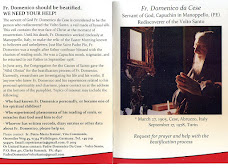
the slab of stone where Christ was laid as it is today in the Church of the Holy Sepulchre in Jerusalem
continuing my translation of Paul Badde's article from Il Volto Santo di Manoppello, Dec. 2009.
In his recounting of those moments John speaks above all of cloths, in greek "othonia", that is, a plural form of the noun. So there was more than one cloth that he had seen lying in that place as is customary for the traditional jewish burial rites. It is clear that among these cloths there was found the large "Shroud". Certainly there was also the "Sudarium" which is preserved in Oviedo in Northern Spain. This had been spread over the face of the crucified one immediately after his death in order to collect the blood which gushed from his mouth after his last breath; and was certainly buried together with Jesus. This cloth however does not contain any image. On it is found only stains from blood and other bodily fluid. The same goes for another "Sudarium", preserved at Cahors in France, which held the chin of Jesus in place. This also was buried together with the body of Jesus, and in the same way, does not show any image. The "image" appearing on the Shroud of Turin, however, Peter could not already have been able to see in the tomb. It was not possible to unfold the cloth there. For the place was too narrow, the room too small to be able to spread it out. The Shroud, as is well known, measures four meters in length (more than twelve feet). But it is not however the marks of blood that make the Shroud mysteriously symbolic but the image of Christ itself.
John, after having twice mentioned the "cloths", speaks again in a specific way of the "Sudarium" that was wrapped around the head of Jesus, but that had not been found "placed" together with the other wrappings, but instead folded in a "special" place and the designation of place remains an enigma. This sudarium had been apparently placed by itself, separated from the other cloths. John lends particular attention to this singularity in a passage which is extremely brief. But if it was like this, then the sudarium must have been laid out on the ground. The possibility of another separate place alongside the slab of stone at the right side of the narrow corridor does not exist. Immediately behind the rocky bed there rises up solid rock. The slab was not a bed in which something could disappear in one of its folds. Another place, outside or alongside, does not correspond to the actual space of the tomb, whose simple structure points to the position of the small veil in only one way. The text by itself could not have any other meaning, in respect to the other cloths in that specific place, than "on the floor of the chamber" at the feet of Peter.





No comments:
Post a Comment